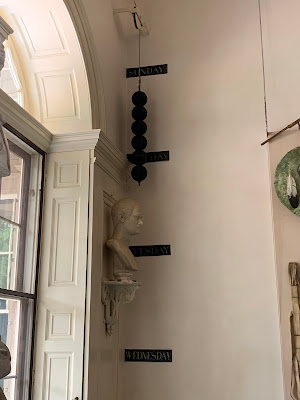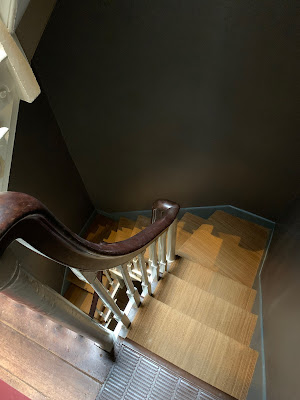Next stop on the history tour was Monticello, the home of Thomas Jefferson.
Monticello was the primary plantation of Thomas Jefferson, who began designing Monticello after inheriting land from his father at the age of 26. The plantation was originally 5,000 acres originally cultivating tobacco and mixed crops, later shifting from tobacco to wheat in response to changing markets. Due to its architectural and historic significance, the property has been designated a National Historic Landmark. In 1987, Monticello and nearby University of Virginia, also designed by Jefferson, were together designated a UNESCO World Heritage Site.
Work began on Monticello in 1768 and Jefferson moved into an outbuilding known as the South Pavilion in 1770, where his new wife Martha Wayles Skelton joined him in 1772.
South Pavilion
Jefferson continued work on his original design, but how much was completed is of some dispute.
After his wife's death in 1782, Jefferson left Monticello in 1784 to serve as Minister of the United States to France. During his time there, he had an opportunity to see some of the classical buildings with which he had become acquainted from his reading, as well as to discover the trends in French architecture that were then fashionable. His decision to remodel his own home may date from this period. In 1794, Jefferson began rebuilding his house based on the ideas he acquired in Europe. The remodeling continued throughout most of his presidency (1801-1809) and while it was generally completed by the end of his term, he continued work on the present structure until his death in 1826.
Visiting Monticello is much different than it was about 25 years ago when we visited. A ticket is required and we were happy we had bought our tickets online about 10 days before we went. After parking in one of the many parking lots, you climb aboard a shuttle to take you to the house for the beginning of the tour.
After a brief introduction, we headed into the house and spent some time in the foyer. The clock shows one of Jefferson's many inventions. The clock was designed by Jefferson, built in 1792, and fully functional today.
The clock has both an interior and exterior face and it dictated the schedule of the entire plantation, inside and out. On the outside wall, the clock has only an hour hand, which Jefferson believed was accurate enough for outside laborers. The inside face of the clock reveals much greater precision by offering not only hour and minute hands, but also a smaller dial for a second hand.
The clock is driven by two sets of cannonball-like weights, which hang on both sides of the front doors. On Sundays the clock is wound with the help of a folding ladder, and the weights are raised to the ceiling. The top ball right-hand set of weights reveals the day and approximate hour as it falls past markers on the wall, with Sunday at the top and Saturday at the bottom. The clock is also attached to a gong that chimes the hour and in the eighteenth century, it rang loudly enough for field slaves to hear it three miles away.
However, there was a problem when it was discovered that the clock was really a six-day clock. Upon the arrival of weights for its installation, it was discovered that the height of the Entrance Hall was shorter than the length of the ropes. But Jefferson had a solution - to allow the weights to descend until they get to the floor where they could then go through holes and Saturday (day 7) would be in the basement.
We visited on a Sunday
Now the clock and weather vane we'd seen on the porch made more sense. You can see the exterior clock on the right of the picture below. The compass rose on the ceiling was connected to the weathervane on the roof. This way, Thomas Jefferson and his family could determine the wind direction without stepping outside by looking from the windows in the entrance hall. If you look at the photo of the clock above, you can see how they could stand there and look out the windows above the clock.
We moved on to the main bedroom. When we later climbed the stairs to the second and third levels, I figured out why Jefferson chose to have his bedroom on the first floor.
You could understand Jefferson's love of books right as you walked into his office/bedroom.
Books behind the plexi-glass, 5th row from the top, are originals
One of the items I remembered vividly from our last visit was his bed but I was disappointed that the guide didn't talk about it on this visit. Jefferson was able to get out of bed on either side depending on how he wanted to start his day. You can see the office portion of the bedroom and we were standing in the more traditional part of the bedroom. If he wanted to work, he got out on that side - if he didn't, he got out towards where we were standing. Genius!
Jefferson loved gadgets and the polygraph, a two pen copying machine, was among his favorites. He called it "the finest invention of the present age" and made copies of many letters he wrote after he got it in 1804. You can see it on the office side of the bed above with a closer view below. Remember, all of this was done with a quill dipped into ink.
This was an interesting item in the dining room - a dumbwaiter to bring the wine up from the cellar.
We went up the very narrow, steep stairs - see why Jefferson was happy to have his bedroom on the first floor?
James and Dolley Madison, who lived nearby, were frequent visitors to the house and because they visited so often, the Jefferson grandchildren called the bedroom they used simply "Mr. Madison's room". Dolley is said to have said that the alcove bed was cozy in the winter but dreadful in the summer.
Anna Scott Jefferson Marks (1775-1828) was the youngest sister of Thomas Jefferson. As a young adult, Jefferson oversaw her financial affairs, a practice he continued throughout her life, and the entanglement of his finances and hers made his stewardship of her assets problematic. As a result, while he provided his sister support, she never gained independent control of her finances.
After her husband's unexpected death in 1811, Anna joined Thomas Jefferson's household at Monticello. Once her husband's debts were satisfied, her inheritance amounted to just a few possessions so she lived under the protection of her brother for the rest of her life. She probably brought some of her furnishings with her that dated from her marriage in 1787.
I failed to take a photo - this is by Walter Smalling Jr. @ Thomas Jefferson Foundation of Monticello
This dresser was the original of Jefferson's daughter. We wonder how they got it up those stairs.
There was a room set up for the grandchildren.
We then went up to the third floor to see the Dome Room. Although it is beautiful with large circular windows and skylight, the function of the room is not completely understood.
Skylight
The only long-term occupants of the Dome Room were Jefferson's grandson, Thomas Jefferson Randolph, and his bride who lived in the room for a number of months starting in 1815. By Jefferson's death in 1826, if not before, the room had primarily been used as a storage area.
The grandchildren discovered a secret room off of the Dome Room which they named the fairy palace. They loved to play in this room and it is decorated today as the curators felt it would have been at that time.
And now it was time to go back down the narrow, steep stairs. YIKES!!!
We went into the cellar and saw the kitchen.
And then down the long hall....
.....to see the beer and wine cellars.



We walked to see the back of the house and learned that they were setting up for an Independence Day celebration the following day, July 4th. We originally wanted to tour the house on the 4th but found that they were not selling tickets for that day so we went on the 3rd. Turns out the house was open for self-tours but the "real" event was a naturalization ceremony in the back.
Wait, that view looks familiar. Hmmm, where have we seen it before?
It's a nickel!
Time to move on to the graveyard.
Thomas Jefferson prepared the words that would be on his headstone upon his death based on what achievements during his life he was most proud of. Notice that the stone does not mention that he was the third president of the United States.
Thomas Jefferson's mother is buried here.
We left the cemetery and walked along Mulberry Row on our return to the house. Mulberry Row was the hub of Jefferson's agricultural enterprise. As the principal plantation street, it was the center of work and domestic life for dozens of people - free whites, free blacks, indentured servants and enslaved people.
There we saw the grave of Rachel Levy. When the guide told us about the family, she pronounced it Leh-vy. I looked at Ron and rolled my eyes and when the guide saw me, I'm sure she thought I was terribly disrespectful. So I explained why I was questioning her and she confirmed that, yes, it was pronounced Leh-vy.
As we walked back to the shuttles, we saw this.
After a lengthy visit, it was time to head back to the RV park. But we decided to stop at an historic spot.
In 1746, Major John Henry sold land in Albemarle County to John Michie. John's son, William Michie, inherited the property from his father and built a house. Many people came to his house looking for food and a place to sleep, so in 1784 William obtained a license to operate a tavern, inn, and restaurant. The property reverted to state ownership in 1910 when Sally Michie was unable to care for the business. She was the last Michie family member to own the property. It was purchased by Josephine Henderson in 1927, and she had it dismantled and moved near Monticello. Part of her interest in the tavern was to have a place to display her large collection of antiques. It was used as an architectural office by Milton Gregg beginning in 1932.
Of course, since it was time for lunch (although late) you know what came next.
There was a nice buffet.
Dining room
And with that, it was officially time to leave and head back to our "home" after a long day.












































Oh this makes me want to go visit Monticello again. So much more is open than when I last visited.
ReplyDeleteIt's completely changed on the outside from the last time we were there.
Delete